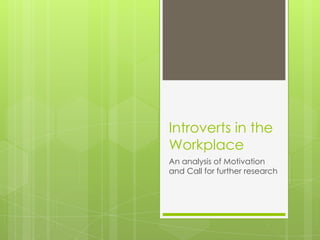
Au Psy492 M7 A2 Marrero B
- 1. Introverts in the Workplace An analysis of Motivation and Call for further research
- 2. motivation Workflow/job design effect motivation Cognitive theories of motivation People make conscious decisions of motivation Individual’s personalities, values and ideals determine which factors are most important
- 3. Extrinsic/Intrinsic Motivation Extrinsic Factors factors externally controlled or mediated by other people Salary, Benefits, rewards, recognition Intrinsic Factors Factors internally controlled Differ for each person Role ambiguity, situational or contextual factors, education, history and interpersonal relationships
- 4. Personality Extroversion-introversion scale Regards how a person prefers to expend their mental energy. Inwardly or outwardly. Most mainstream theories agree on the traits of this scale Meyers-Briggs trait inventory (MBTI) Eysenck’s factor theory
- 5. Extroversion/Introversion Socially outgoing Socially reserved Energized by high Drained by high activity and social activity and social interaction interaction Enjoy louder more Enjoy quieter crowded settings settings with High tolerance for fewer, closer stimuli friends Sensitive to stimuli
- 6. Misconceptions of Introverts Social shyness May be seen as a dislike of people Sometimes interpreted as ‘suspicious’ Preference for small groups Often considered ‘party poopers’ Extroverted friends do not understand Sensitivity to stimuli May be interpreted as anger or a bad attitude
- 7. Strengths of Introverts Foster closer interpersonal relationships with fewer people Preference for one-on-one interaction Tend to be more conscientious of their actions Internal focus lends more thought to actions Theirsubjective internal worlds foster good creativity Artists tend to be introverts
- 8. Motivation of Extroverts Tend to be more motivated by extrinsic factors than Introverts Commission Rewards programs Intrinsic factors Likely more connected to social factors
- 9. Motivation of Introverts? More motivated by intrinsic factors? Their internally focused energy logically would have them more focused intrinsically Social factors still play but likely have a different impact
- 10. Conclusion Research is limited on Introverts motivation To make the adequate conclusion we must perform more research in this field Understanding of the strengths and weaknesses of introverts and extroverts will decrease misconceptions and create better work environments